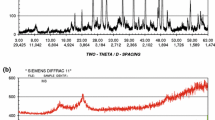Abstract
The fraction of swelling-type clay minerals (smectites) is a first measure to estimate the swelling potential of natural rocks. This swelling potential is only activated if water can be incorporated in the sheet silicates. The samples studied in this work are volcanic rocks from the Southern Andes. According to the petrographic and mineralogical studies, the rocks are characterized as vulcanite with high content of smectite. Undisturbed samples showed minor swelling behaviour in conventional swelling tests, although X-ray diffraction and differential thermal analysis revealed swelling clay contents of more than 70 % in some samples. Powder swelling tests were performed on ground and recompacted rock samples. The results of these tests show a better agreement with those expected according to the mineralogical composition of the samples. The reason for the non-activation of the swelling potential in undisturbed samples was suspected to be the influence of the iron-oxide/hydroxide content, which was on average around 11 %. Scanning electron microscope images showed that the edge terminations of the clay particles are coated with hematite. The hydrophobic properties of hematite impede the access of water between the interlayers of the clay minerals and, in addition, hematite cementation prevents the expansion. In a further series of swelling tests water was replaced by a reducing solution (0.1 molar hydroxylammonium chloride) which removes the Fe-oxide coating. It can be shown that thus the swelling potential of the clay minerals in such undisturbed rocks can be activated.












Similar content being viewed by others
References
Benway HM, Haley BA, Klinkhammer GP, Mix AC (2003) Adaptation of a flow-through leaching procedure for Mg/Ca paleothermometry. Geochem Geophys Geosyst 4(2):8403. doi:10.1029/2002GC000312
Castro SO, Van Sint Jan M, Gonzalez RE, Lois PV, Velasco LE (2003) Dealing with expansive rocks in the Los Quilos and Chacabuquito water tunnels—Andes Mountains of central Chile. In: Proceedings of the 10th ISRM congress, Sandton (South Africa), pp 185–193
Charrier R, Pinto L, Rodríguez MP (2007) Tectonostratigraphic evolution of the Andean Orogen in Chile. In: Moreno T, Gibbons W (eds) The geology of Chile, The Geological Society, London, pp 1–114
Frost RL, Vassallo AM (1996) The dehydroxylation of the kaolinite clay minerals using infrared emission spectroscopy. Clays Clay Miner 44(5):635–651
Grob H (1972) Schwelldruck im Belchentunnel. In: Proceedings of international symposium für Untertagebau, Luzern (Switzerland), pp 99–119 (in German)
Haley BA, Klinkhammer GP (2002) Development of a flow-through system for cleaning and dissolving foraminiferal tests. Chem Geol 185:51–69
Hillier S (2003) Quantitative analysis of clay and other minerals in sandstone by X-ray powder diffraction (XRPD). In: Worden RH, Morad S (eds) Clays and clay cements in sandstones. International association of sedimentologists special publication number 34, pp 213–251
International Centre for Diffraction Data-ICDD (2002) PDF-2 Powder diffraction file release 2002. ISSN 1084-3116
Kramar U (1997) Advances in energy dispersive X-ray fluorescence. J Geochem Explor 58:73–80
Moore DM, Reynolds RC (1997) X-ray diffraction and the identification and analysis of clay minerals, 2nd edn. Oxford University Press, New York
Pimentel E (2003) Swelling behaviour of sedimentary rocks under consideration of micromechanical aspects and its consequences on structure design. In: Natau, Fecker, Pimentel (eds) Geotechnical measurements and modelling, Swets & Zeitlinger, Lisse, pp 367–374
Rosenthal Y, Boyle ED, Slowley N (1997) Temperature control on the incorporation of magnesium, strontium, fluorine and cadmium into benthic foraminiferal shells from Little Bahama Bank: prospects for thermocline paleoceanography. Geochim Cosmochi Acta 61:3633–3643
Thuro K (1993) Der Pulverquellversuch—ein neuer Quellhebungsversuch. Geotechnik 16:101–106 (in German)
Acknowledgments
The work described in this paper was carried out in different institutions within the Karlsruhe Institute of Technology (KIT), Karlsruhe, Germany. The authors thankfully acknowledge the help of Cristian Osan and Marianne Metz with the swelling tests performed at the IBF. At the Institute of Mineralogy and Geochemistry Kristian Nikolowski was involved in the sample preparation and Beate Oetzel carried out the XRD and CSA measurements. The authors express their special gratitude to Volker Zibat for his support with SEM–EDX analyses carried out at the Laboratory for Electron Microscopy (LEM). DTA investigations were carried out at the Institute of Functional Surfaces (IFG) by Annett Steudel and Katja Emmerich. We would like to emphasize that without the support of all these colleagues, these investigations would not have been possible.
Author information
Authors and Affiliations
Corresponding author
Rights and permissions
About this article
Cite this article
Mutschler, T., Kramar, U., Vergara, M.R. et al. Influence of Hematite Coating on the Activation of the Swelling Potential of Smectite-Bearing Rocks. Rock Mech Rock Eng 46, 835–847 (2013). https://doi.org/10.1007/s00603-012-0289-z
Received:
Accepted:
Published:
Issue Date:
DOI: https://doi.org/10.1007/s00603-012-0289-z




